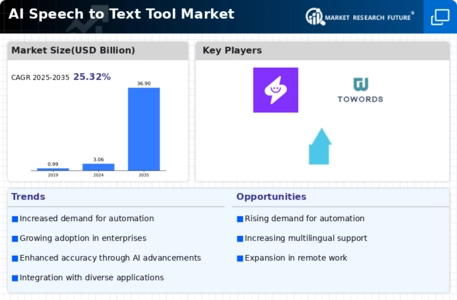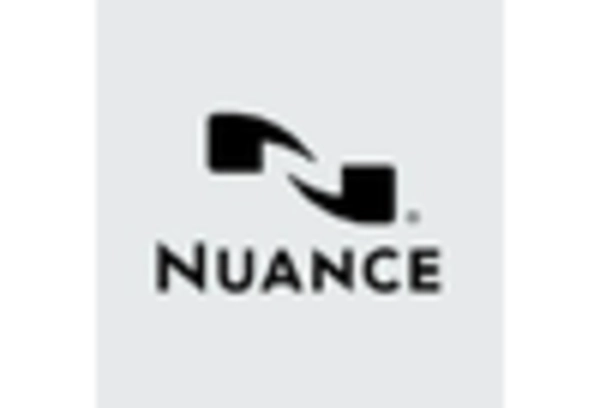The AI Speech to Text Tool Market is currently characterized by a dynamic competitive landscape, driven by rapid technological advancements and increasing demand for automation across various sectors. Major players such as Google (US), Microsoft (US), and IBM (US) are at the forefront, leveraging their extensive resources to innovate and enhance their offerings. Google (US) focuses on integrating its speech recognition technology into various applications, thereby enhancing user experience and accessibility. Meanwhile, Microsoft (US) emphasizes partnerships and collaborations, particularly in the healthcare sector, to expand its market reach and improve service delivery. IBM (US) appears to be concentrating on enterprise solutions, tailoring its offerings to meet the specific needs of businesses, which collectively shapes a competitive environment that is both collaborative and competitive.
The market structure is moderately fragmented, with numerous players vying for market share. Key business tactics include localizing services to cater to regional languages and dialects, optimizing supply chains for efficiency, and investing in research and development to stay ahead of technological trends. The collective influence of these key players fosters a competitive atmosphere where innovation is paramount, and companies are compelled to differentiate themselves through unique value propositions.
In August 2025, Google (US) announced the launch of its latest AI-driven speech recognition model, which reportedly offers improved accuracy and faster processing times. This strategic move is significant as it not only enhances Google's competitive edge but also reinforces its commitment to providing cutting-edge technology that meets the evolving needs of users. The introduction of this model is likely to attract a broader user base, particularly in sectors requiring high levels of transcription accuracy.
In September 2025, Microsoft (US) expanded its partnership with a leading telehealth provider to integrate its speech-to-text capabilities into virtual consultations. This initiative is strategically important as it positions Microsoft (US) as a key player in the burgeoning telehealth market, where accurate and efficient documentation is critical. By enhancing its offerings in this sector, Microsoft (US) is likely to capture a significant share of the healthcare market, which is increasingly reliant on digital solutions.
In July 2025, IBM (US) launched a new suite of AI tools designed specifically for the legal industry, which includes advanced speech-to-text functionalities. This move is indicative of IBM's strategy to penetrate niche markets by providing tailored solutions that address specific industry challenges. The legal sector's demand for precise documentation and compliance makes this a potentially lucrative avenue for IBM (US), further diversifying its portfolio.
As of October 2025, the competitive trends in the AI Speech to Text Tool Market are increasingly defined by digitalization, sustainability, and the integration of advanced AI technologies. Strategic alliances are becoming more prevalent, as companies recognize the value of collaboration in enhancing their technological capabilities and market reach. Looking ahead, competitive differentiation is likely to evolve from traditional price-based strategies to a focus on innovation, technological advancement, and supply chain reliability, as companies strive to meet the growing expectations of consumers and businesses alike.

















Leave a Comment